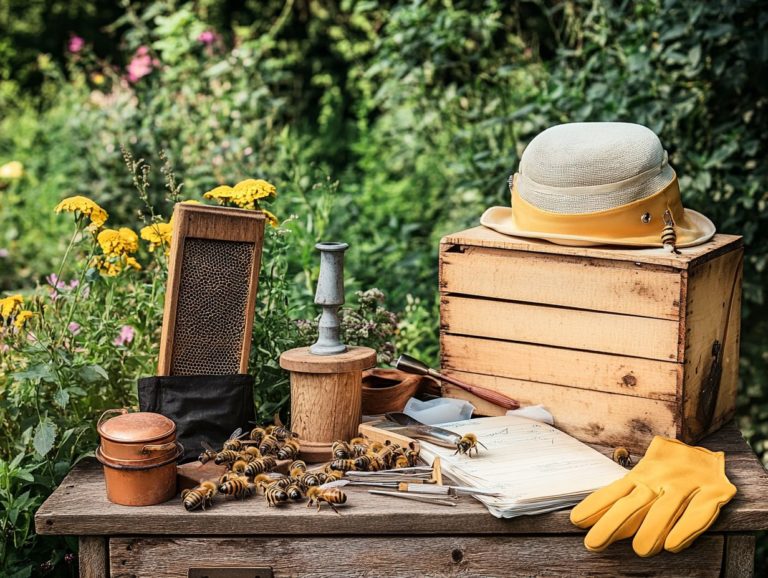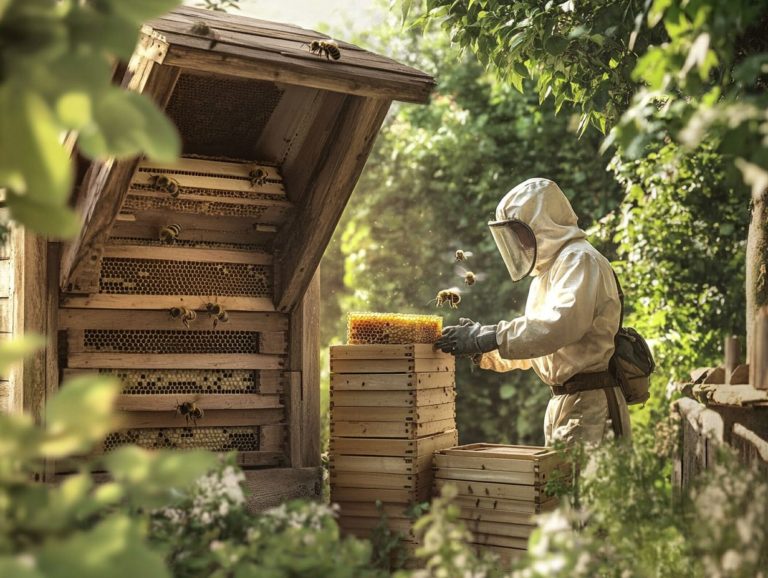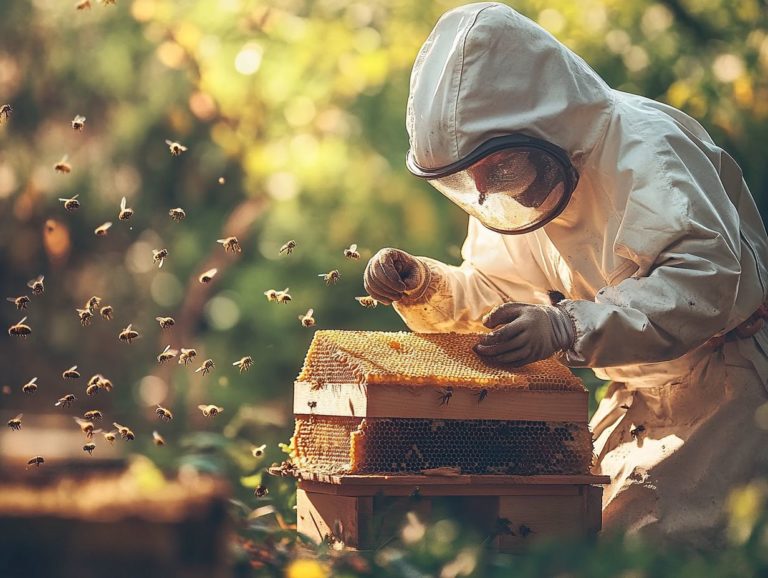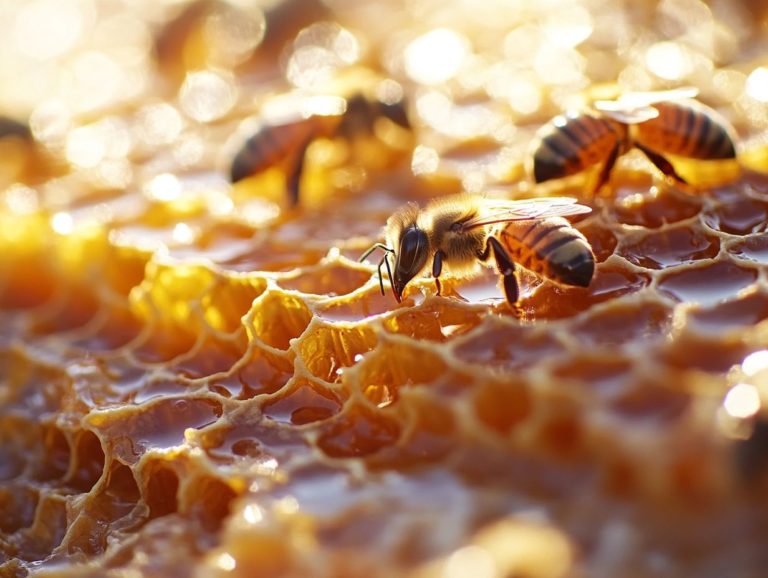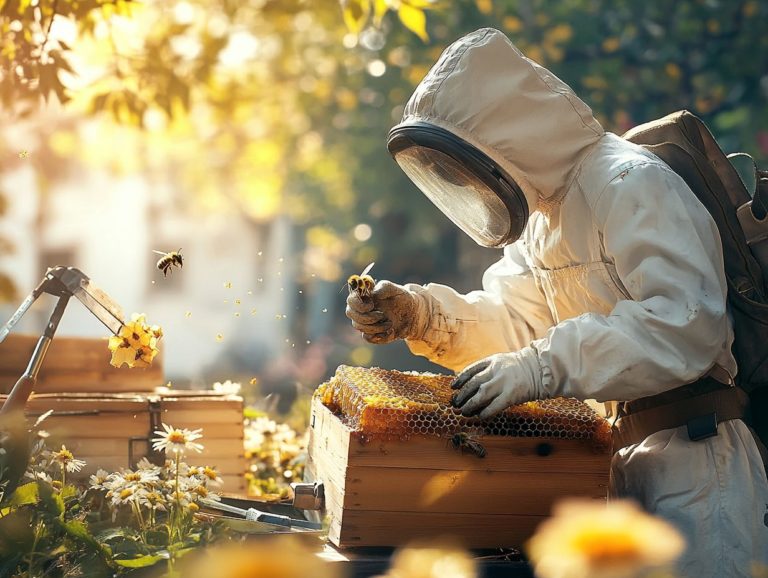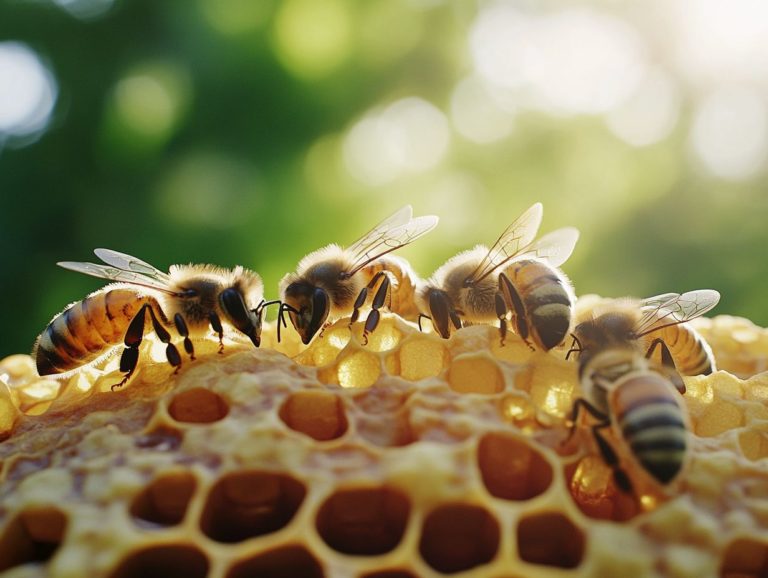Signs Your Hive Needs Management
Managing a beehive is essential for the well-being of the colony and maximizing honey production. This is crucial for sustainable beekeeping.
Understanding hive nuances and knowing when it needs attention can profoundly impact your success as a beekeeper.
This article covers common signs that your hive may need management. Look for decreased honey production, changes in bee behavior, and signs of disease, along with vital tips for effective hive care.
Explore how to cultivate a thriving, productive environment for your bees.
Contents
- Key Takeaways:
- Signs Your Hive Needs Management
- How to Manage Your Hive
- Frequently Asked Questions
- What are some signs that my hive needs management?
- Why is a decrease in honey production a sign that my hive needs management?
- How can an increase in pest activity signal the need for hive management?
- What does too much drone brood mean for my hive?
- Why is monitoring the health of my hive important for management?
- What should I do if I notice any of these signs in my hive?
Key Takeaways:
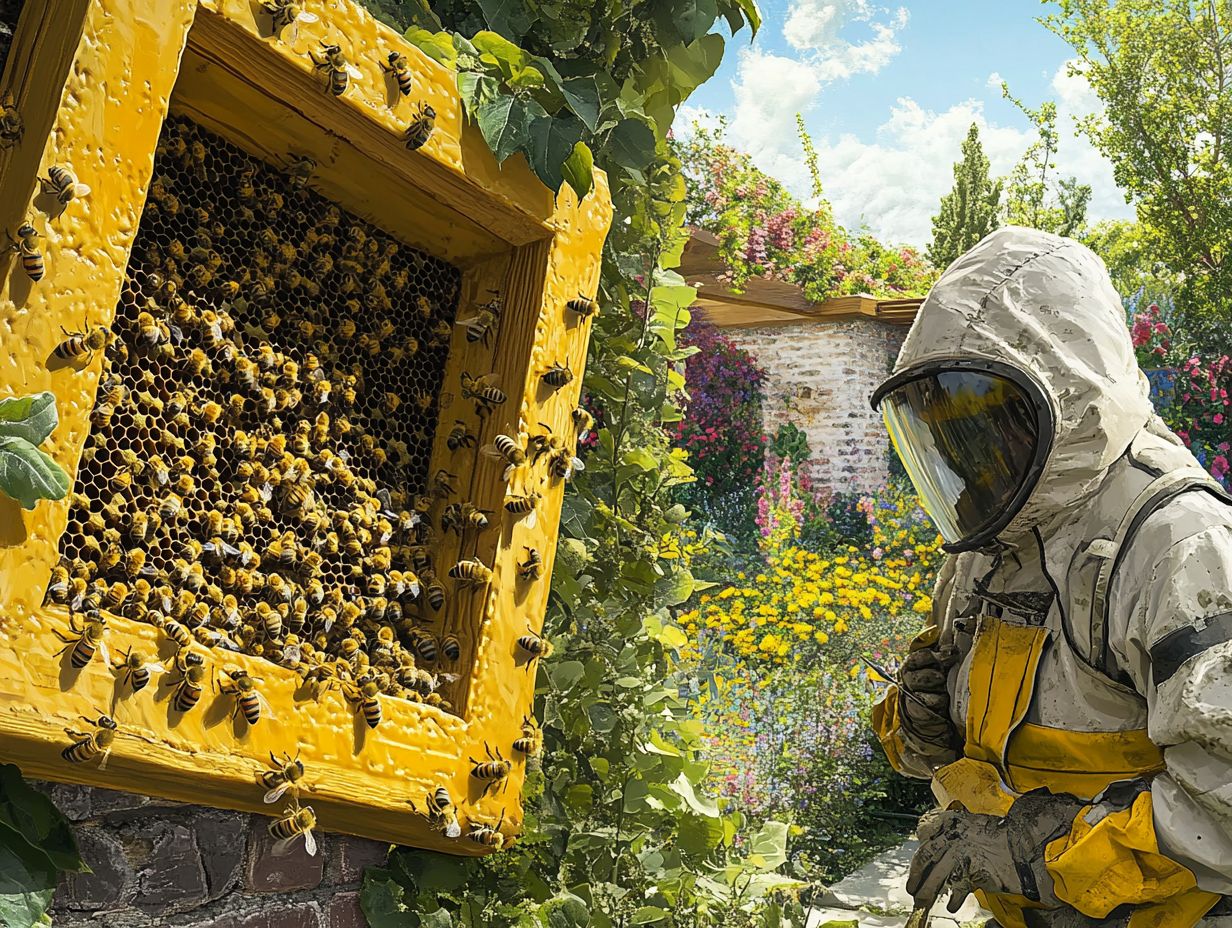
- Regular hive inspections are crucial for identifying potential issues such as decreased honey production and changes in bee behavior.
- Keeping a clean and organized hive helps prevent pests and diseases, ensuring a healthy environment.
- Providing adequate food and water, and controlling pests are essential for a productive hive.
What is a Hive?
A hive, or beehive, is a carefully built living space for bees. It serves as the heart of their community activities, from honey production to brood rearing.
Within this bustling ecosystem, you’ll find various bee species. This includes the queen bee, worker bees, and drones, all working together to maintain the colony’s health.
As you look deeper, you’ll see bees constructing intricate combs to store pollen, nectar, and honey. This ensures a sustainable food supply throughout the seasons, especially during nectar flows.
The hive’s architecture features hexagonal wax cells, designed to save space and enable efficient storage. Each type of bee has a crucial role: the queen reproduces, worker bees forage and maintain the hive, while drones mate with the queen.
The hive’s location in an apiary is vital. It affects access to flowers for foraging and provides protection from harsh weather and predators.
Why is Hive Management Important?
Good hive management is vital for you as a beekeeper. It keeps your bee colonies healthy and productive, while minimizing risks from pests and diseases like varroa mites, a common pest that harms bees.
Regular inspections help you assess the hive’s status. Make sure the queen is thriving and there s enough food supply to support the colony through changing seasons.
Incorporating strategies like integrated pest management (IPM) can elevate your approach. This enables sustainable practices that lower the need for chemical treatments.
Swarm prevention techniques are crucial for maintaining the strength of your colony. Ensure there is enough space and resources for the bees.
Being in tune with seasonal rhythms allows you to adapt your practices. This promotes resilience even during harsh conditions.
By focusing on biodiversity and forage options, you create an environment for your bees to thrive. This leads to the successful production of high-quality honey while supporting the wider ecosystem.
Signs Your Hive Needs Management
Recognizing the signs that your hive requires management is essential for sustaining a healthy and thriving colony. As a beekeeper, it’s vital to remain vigilant for indicators like a decline in honey production, rising pest infestations, and noticeable changes in bee behavior.
You should also be on the lookout for queen cells (the structures where new queens develop), irregular brood patterns, and any visible signs of disease. These may signal underlying issues that demand immediate attention. Addressing these concerns promptly ensures the ongoing success and overall health of your hive.
1. Decrease in Honey Production
A decrease in honey production can serve as a telling sign that your hive’s status may be compromised. This decline could stem from various factors, including insufficient nectar flow, issues with bee health, or subpar hive management practices.
Environmental influences like climate change, pesticide usage, and habitat loss critically impact the foraging patterns and overall well-being of bee populations. These challenges become even tougher with changes in bee behavior driven by stressors like diseases and parasites. These can weaken colonies and hinder their ability to produce abundant honey.
To address these concerns, grasp the dynamics within your hive. Pay attention to queen health and worker productivity to spot potential interventions. Implement strategies such as organic pest control, fostering pollinator-friendly habitats, and ensuring your bees receive adequate nutrition to significantly boost honey yields.
This proactive approach helps you have a sustainable future in beekeeping while reinforcing the vital role bees play in our ecosystem.
2. Increase in Pest Infestations
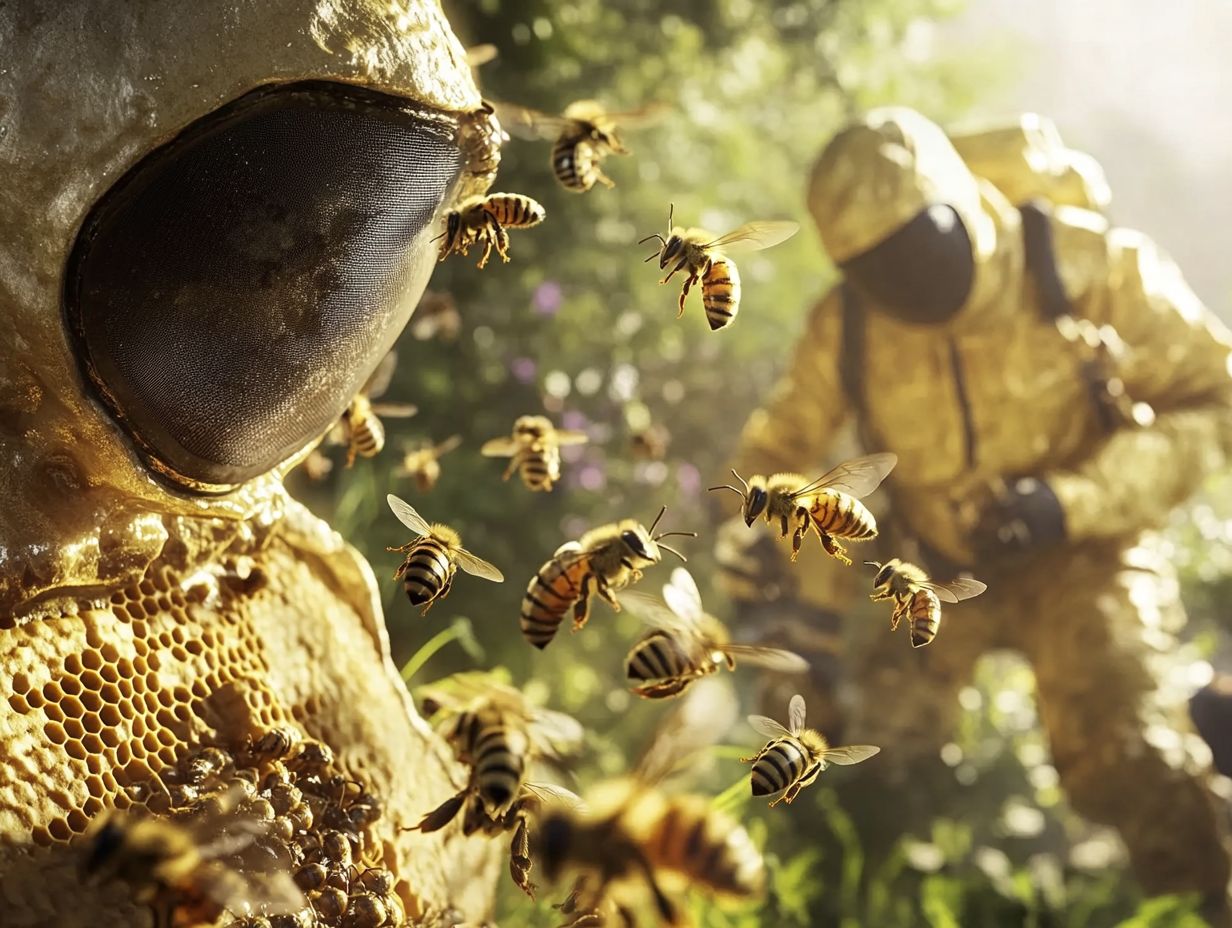
An uptick in pest infestations, particularly from varroa mites, presents a serious threat to the health and productivity of your hives. If left unaddressed, these issues can weaken your colonies and significantly reduce honey yields.
These minuscule yet destructive parasites attach themselves to bees and feast on their bodily fluids. This diminishes the bees’ strength and undermines their immune systems. As a result, hives affected by varroa mites become increasingly vulnerable to diseases, jeopardizing the survival of the entire colony.
To combat these invaders, implement robust management strategies. Routinely monitor your colonies for signs of infestation, utilizing methods like drone brood removal and spot treatments with approved miticides. Nurturing strong colony genetics through selective breeding bolsters resilience against pests, ensuring healthier bee populations and sustainable honey production over the long term.
3. Changes in Bee Behavior
Changes in bee behavior, such as excessive fanning or bearding outside the hive, can be telltale signs of stress, overcrowding, or environmental challenges. These warrant your immediate attention as a beekeeper to ensure that the hive is properly protected and managed.
These behaviors often act as red flags for underlying issues like insufficient ventilation or a lack of space for the colony to expand. When you observe bees fanning excessively, it’s usually their instinctive way of regulating temperature and humidity within the hive, suggesting that the internal conditions may not be quite up to par.
On the other hand, witnessing bees clustering on the outside of the hive known as bearding can indicate overcrowding or a potential need for additional resources. It may also signal that they are preparing to swarm.
Recognizing and interpreting these signals is essential. Timely interventions can significantly enhance the health and productivity of the colony. By acting on these indicators, you can implement effective strategies for resource allocation or hive relocation, ultimately safeguarding the hive and ensuring its success in the industry.
Take action today to ensure your bees thrive!
4. Presence of Queen Cells
The presence of queen cells is a crucial indicator that your colony may be gearing up to swarm or replace its current queen. This situation calls for your immediate attention to safeguard the hive s productivity and health.
Understanding the importance of these queen cells is essential, as they reveal not only the possibility of a new queen but also the current dynamics within the colony. When a hive starts producing queen cells, it often reacts to stressful conditions in the environment or health issues. This signals the need for your careful management to prevent swarming.
You should keep a close eye on these structures and consider strategies such as performing a split or ensuring there s adequate space within the hive to alleviate any overcrowding. Regularly inspecting the brood patterns and overall condition of the hive will enable you to maintain a thriving colony, ensuring it remains robust and productive throughout the season.
5. Uneven Brood Pattern
An uneven brood pattern can signal underlying issues within your hive, such as a failing queen or poor hive health. This makes it crucial for you to conduct regular inspections to monitor and address these concerns.
By examining the distribution of brood cells from tightly clustered patterns to sporadic gaps you gain valuable insights into the overall well-being of your colony. A healthy brood pattern typically reveals a solid, consistent layout with minimal empty cells, indicating an active and productive queen.
Scattered or drone-heavy brood patterns may suggest potential problems, such as disease or stress within the hive. Understanding these nuances allows you to intervene promptly and enhances your hive management strategies. Additionally, recognizing signs your hive is thriving ensures your bees remain robust, thriving, and queen right.
6. Visible Signs of Disease
Act quickly when you see visible signs of disease within a hive like abnormal bee behavior, dead bees, agitated bees, or indications of infection. These are serious red flags that demand immediate inspection and intervention to safeguard bee health and prevent further spread.
These symptoms often indicate common ailments such as Varroa mites tiny parasites that attach to bees and can cause severe harm to your colony Nosema, or American foulbrood. It s essential for you to recognize early indicators, including diminished brood patterns, a drop in foraging activity, or unusual clustering behavior. These may all hint at underlying health issues that need your attention.
Embracing sound management strategies is vital. Regularly monitor the hive status of your colonies, integrate pest control measures with care, and ensure optimal hive conditions. By maintaining a clean environment and implementing effective treatment protocols, you not only mitigate these threats but also enhance the overall vitality of your colonies. This supports the critical role bees play in our ecosystem and ensures a healthy hive.
How to Manage Your Hive
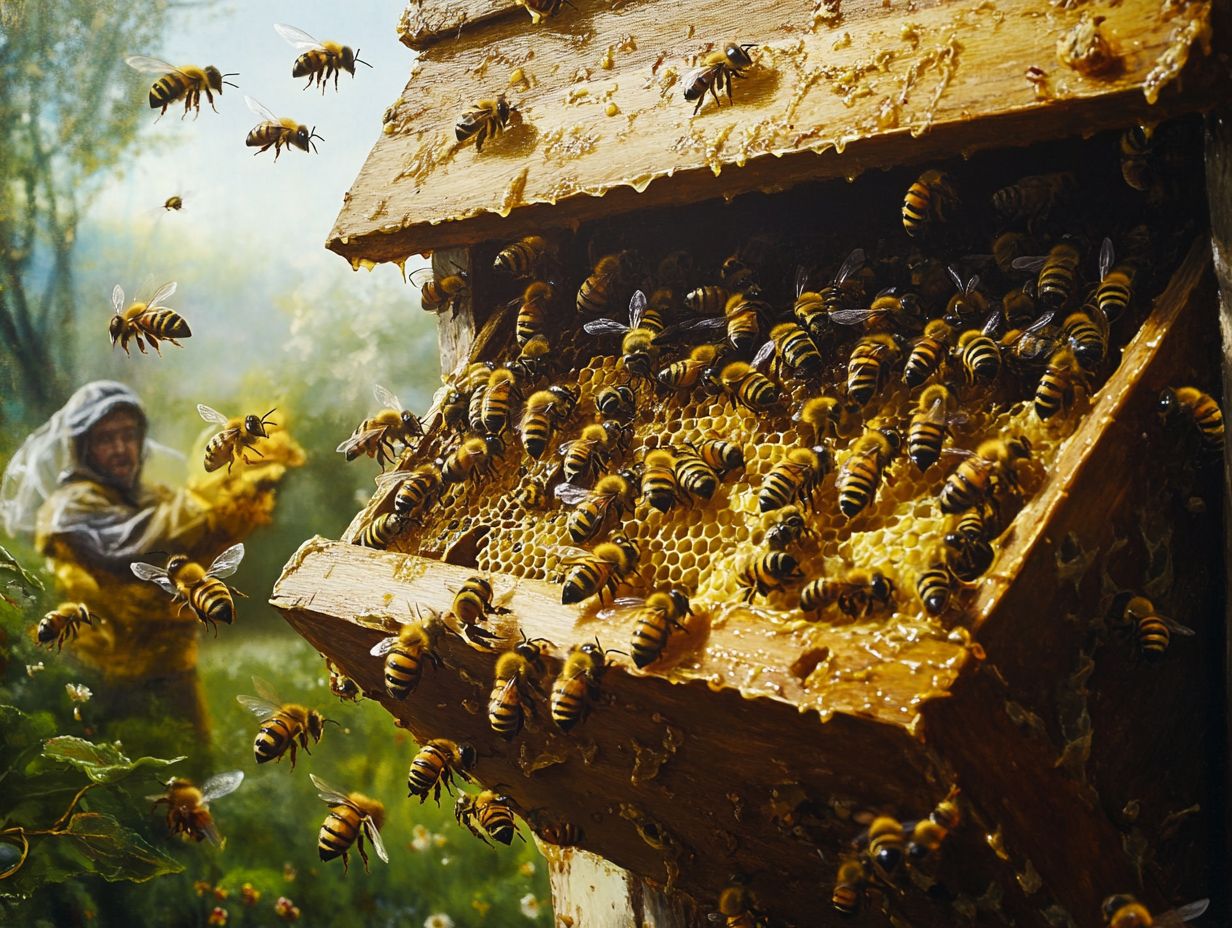
Effectively managing your hive requires a thoughtful blend of regular inspections, maintaining a pristine environment, controlling pests, and ensuring a sufficient food supply to support the health and productivity of your bees.
Each of these essential actions enables you to adopt a proactive approach to hive management, which can profoundly influence honey production and the overall well-being of your colony.
Start inspecting your hives today to keep your bees healthy and productive!
1. Regular Inspections
Conducting regular hive inspections is paramount for you as a beekeeper, especially during different seasons and weather conditions. These assessments allow you to evaluate the brood pattern, monitor bee behavior, and gauge the overall health of your hive. This enables you to identify potential issues, such as new brood patterns or changes in larva development, before they escalate into critical problems.
These inspections are not just routine; they are essential for maintaining a thriving colony. You should pay close attention to various factors, such as the presence of diseases, pests like Varroa mites, and the availability of food resources like pollen and nectar. It’s also important to be vigilant for signs of stress or abnormal behavior within the colony, such as aggressive bees or a noticeable decline in foraging activity. Look out for conditions like bearding hive or fanning hive.
By understanding your findings, you can take immediate actions that protect your bees! Documenting your observations and the effectiveness of any management practices will help you build a comprehensive understanding of your colony’s status, whether it involves queen bee health or overall bee health. This proactive approach ensures the health and productivity of your bees while enhancing your beekeeping expertise.
2. Maintaining a Clean and Organized Hive
Maintaining a clean and organized hive is crucial for promoting the health of your bees and preventing diseases. A cluttered environment can attract pests like drone bees and create breeding grounds for harmful organisms, which is the last thing you want for your colony.
To ensure the well-being of your bees, inspect the hive regularly for signs of debris or wax buildup, as these can hinder their ability to function efficiently. By routinely removing old frames and replacing them with clean ones, you enable better airflow and significantly reduce the likelihood of mold growth.
Taking proactive measures, such as checking for pests like Varroa mites, is vital. Employing a method that combines different strategies to manage pests can effectively help mitigate infestations and support a healthy hive.
Ensure your hive structure is sound, with proper spacing between frames. This supports an organized environment and allows your bees to thrive while minimizing stress and potential health risks.
3. Controlling Pests and Diseases
Effective pest control and disease management are critical elements of hive management that significantly influence the health of your colony and its productivity. Ultimately, this affects honey production.
To maintain a thriving hive, adopt a well-rounded approach that emphasizes prevention and monitoring rather than relying solely on chemicals. This holistic method blends biological control, habitat manipulation, and the careful use of chemical treatments only when absolutely necessary, ensuring minimal disruption to your apiary.
Organic alternatives, such as essential oils and natural repellents, are gaining traction among mindful beekeepers like yourself who wish to reduce their environmental impact. By understanding the life cycles of pests and diseases, you can implement timely interventions that not only protect your hives but also maximize your honey yield.
4. Providing Adequate Food and Water
Providing your bees with a sufficient supply of food and water is crucial for maintaining the health and productivity of the hive. This is especially important during winter checks to ensure that your bees have the necessary resources to flourish.
During times of low nectar flow or harsh weather conditions, effectively monitoring and managing food resources helps prevent stress within the colony. Stress often leads to decreased bee activity and overall hive performance. In critical seasons like early spring or late fall, assessing the availability of stored honey and pollen becomes increasingly important.
You can employ various strategies, such as regularly checking hive weight and using feeder systems, to supplement food when natural resources begin to dwindle. Ensuring access to clean water sources is essential, as it supports vital hive activities like brood care and nectar processing.
Bees use pollen baskets, which are containers that bees use to carry pollen, for efficiency. By incorporating these practices into your beekeeping routine, you can cultivate resilient colonies that thrive throughout the year.
Why Proper Hive Management is Crucial for Beekeepers
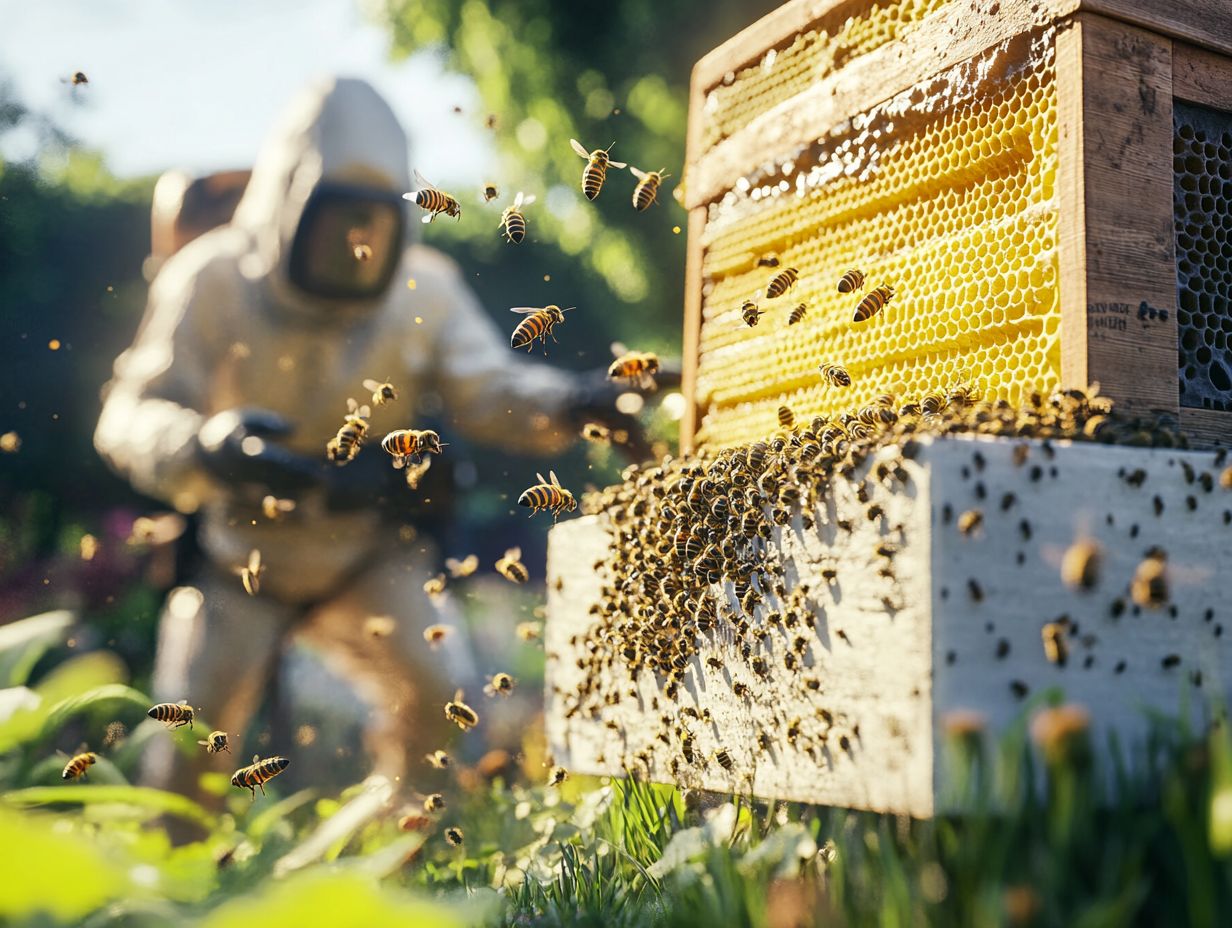
Good hive management is your secret weapon for thriving bees! It directly impacts the health and productivity of your hives, ensuring a well-managed beehive. This influences honey production and plays a vital role in sustaining bee populations crucial for pollination.
When you manage your hives well, you foster stronger colonies more resilient to diseases and environmental stressors. This resilience supports biodiversity and enhances the surrounding ecosystem, benefiting agricultural productivity as well.
Healthy hives lead to better harvest yields, increasing your profitability and contributing positively to local economies. By prioritizing proper hive management, you actively participate in environmental stewardship and promote economic sustainability.
Frequently Asked Questions
What are some signs that my hive needs management?
Wondering why your honey supply is low? Some signs include a decrease in honey production, an increase in pest activity, and excessive drone brood.
Why is a decrease in honey production a sign that my hive needs management?
A decrease in honey production can indicate a weak or sick colony. This may require management actions such as providing supplemental feeding or treating for diseases.
How can an increase in pest activity signal the need for hive management?
An increase in pest activity, such as mites or beetles, can signal a weak or unhealthy hive. Proper management, such as using pesticides or natural pest control methods, can help keep the hive healthy and productive, particularly during periods of low nectar flow.
What does too much drone brood mean for my hive?
Excessive drone brood can indicate a queen problem, such as a failing queen or one that is not properly mated. This may require management actions like requeening the hive.
Why is monitoring the health of my hive important for management?
Regularly monitoring the health of your hive helps identify any potential problems early on. This allows for prompt management and can prevent the loss of the entire colony, keeping your apiary in check.
What should I do if I notice any of these signs in my hive?
If you notice signs of a hive needing management, act quickly! Consult with a beekeeping expert or research the specific issue to determine the best course of action for your hive.

